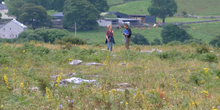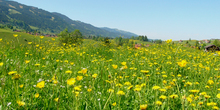Agriculture & Land Management
Our Work
Latest in Agriculture & Land Management
-

Towards sustainability: Future policies for European livestock
The CAP is failing to reward adequately those livestock farmers who produce public goods. Brexit and CAP reform are opportunities to do better.
-
Are Ecological Focus Areas delivering for biodiversity?
Ecological Focus Areas are intended to safeguard and improve biodiversity on arable farms in the EU. What evidence is there that they are actually delivering biodiversity on farmland?
-
Ecological Focus Areas – what are their impacts on biodiversity?
Ecological Focus Areas are intended to safeguard and improve biodiversity on arable farms in the EU. This IEEP study for EEB and BirdLife examined the evidence for potential biodiversity impacts on farmland, taking into account how the areas are being managed.
-
Understanding the consequences of changing biomass demand for energy
Understanding the consequences of increased biomass demand for energy on the environment is central to the development of future policy on renewable energy in Europe. This study seeks to help answer this need by modelling different levels of biomass demand for energy and the consequences for land use and forest based industries.
-
The PEGASUS project publishes its first Newsletter
Welcome to the first newsletter of the PEGASUS project! It provides information on the project’s progress to date and details on the 34 case studies currently underway in 10 EU countries examining how to ensure the improved delivery of public goods and ecosystem services in different farming and forestry situations.
-
Improving environmental financing via result-based agri-environment measures
A new article by IEEP explores the use of result-based agri-environment measures in the region of Baden-Württemberg, Germany. The study shows that result-based schemes can increase the environmental effectiveness and conditionality of the EU Common Agricultural Policy.
-
Learning the lessons from CAP greening
What is the most cost-effective way to encourage basic environmental management across the farmed countryside in the EU-28? Learning from experience to date in greening Pillar 1 of the CAP, this report considers a range of options to increase the environmental added value from greening.
-
New report launch: Call for a new vision for responsible renewable energy with a clear European dimension
Claude Turmes MEP hosted an event launching both IEEP’s report and a debate on the future of renewable energy in Europe. In the our report IEEP present how a resource efficient energy system might be delivered in a way that minimises impact on biodiversity and the wider environment.
-
CAP greening: what are its environmental prospects?
A significant injection of money was agreed for ‘green’ farming practices under the recent CAP reform. This report examines the environmental impact these measures are likely to have on the ground and concludes that Member States’ implementation choices appear to have much diminished the chances of the greening measures delivering significant additional environmental benefits.
-
New PEGASUS website
Project website for EU research project PEGASUS goes live!
-
Results-based agri-environment schemes: new report and guidance handbook available
Are you interested in developing and implementing a results-based payment scheme for farmland biodiversity? Together with experts from across Europe, IEEP has produced a range of useful resources to guide the future development of results-based agri-environment schemes in the EU and beyond.
-
Result-based agri-environment measures: market-based instruments, incentives or rewards?
Result-based schemes are innovative agri-environment measures, which remunerate farmers only if they can demonstrate to have achieved the desired environmental goal. This is different from ...
-
Looking beyond Paris
The latest edition of IEEP's newsletter is now available. David Baldock argues that in the next six months the EU has a substantive role in contributing to agreement on an ambitious but credible set of SDGs and more stretching climate targets. Also: energy efficiency and security; bioeconomy; and circular economy.
-
The Manual: Front pages
This is a chapter of IEEP’s Manual of European Environmental Policy. This chapter provides information on the authors, editors and editorial board involved in the Manual, as well as guidance on how to use it, and a brief outline of its content.
-
The Manual: Chapter 13 - Sectoral policies
This is a chapter of IEEP’s Manual of European Environmental Policy. This chapter sets out the development of some of the most important links between EU environmental policy and other policy areas, such as agriculture, forestry, fisheries, transport, trade, and so on.
-
Whither the new Commission?
IEEP’s David Baldock gives his take on the new Commission in the latest edition of our newsletter. Read about how IEEP is raising ambition for the next EU climate and energy package, plus: priorities and policy options for a circular economy, payments for farmland biodiversity achievements, biodiversity proofing EU spending, and more.
-
Guidelines for biodiversity proofing the EU budget
This report provides a practical framework to ensure that spending under the EU budget has no negative impacts on biodiversity, and that spending under the EU budget is overall supportive to achieving the biodiversity targets.
-
Sustainable intensification of European agriculture
The concept of sustainable intensification has come into prominence in the context of global food security. This report defines what we mean by sustainable intensification, explains its global logic, discusses what it means for EU agriculture and exemplifies this in three case studies for soil performance, nutrient recycling and biodiversity.
-
High Nature Value farming throughout EU-27 and its financial support under the CAP
This study reviews Member States’ estimates of the extent of HNV farmland and use of RDP measures and the CMEF indicators, then identifies future priorities for CAP support for HNV farming and discusses the support opportunities under the reformed CAP. It offers detailed new evidence about the combined effect of Pillar 1 and Pillar 2 CAP payments on the economic and environmental viability of a typical HNV farming system in three Member States.
-
New report: High Nature Value Farming in the EU
Member States need to make the most of the opportunities under the new Common Agricultural Policy if the declines in HNV farming, critical for meeting our 2020 biodiversity targets, are to be halted.
Related
-

Debating the Future of The Common Agricultural Policy
The IEEP's platform to share thoughtful commentary and analysis on the future development of European agriculture and rural development policy.
Highlights
-

Ecological Focus Areas – what are their impacts on biodiversity?
Ecological Focus Areas are intended to safeguard and improve biodiversity on arable farms in the EU. This IEEP study for EEB and BirdLife examined the evidence for potential biodiversity impacts on farmland, taking into account how the areas are being managed.
-

Understanding the consequences of changing biomass demand for energy
Understanding the consequences of increased biomass demand for energy on the environment is central to the development of future policy on renewable energy in Europe. This study seeks to help answer this need by modelling different levels of biomass demand for energy and the consequences for land use and forest based industries.
-

Learning the lessons from CAP greening
-

CAP greening: what are its environmental prospects?
-

Results-based agri-environment schemes: new report and guidance handbook available
-

Result-based agri-environment measures: market-based instruments, incentives or rewards?
-

Redesigning the CAP to deliver public goods
